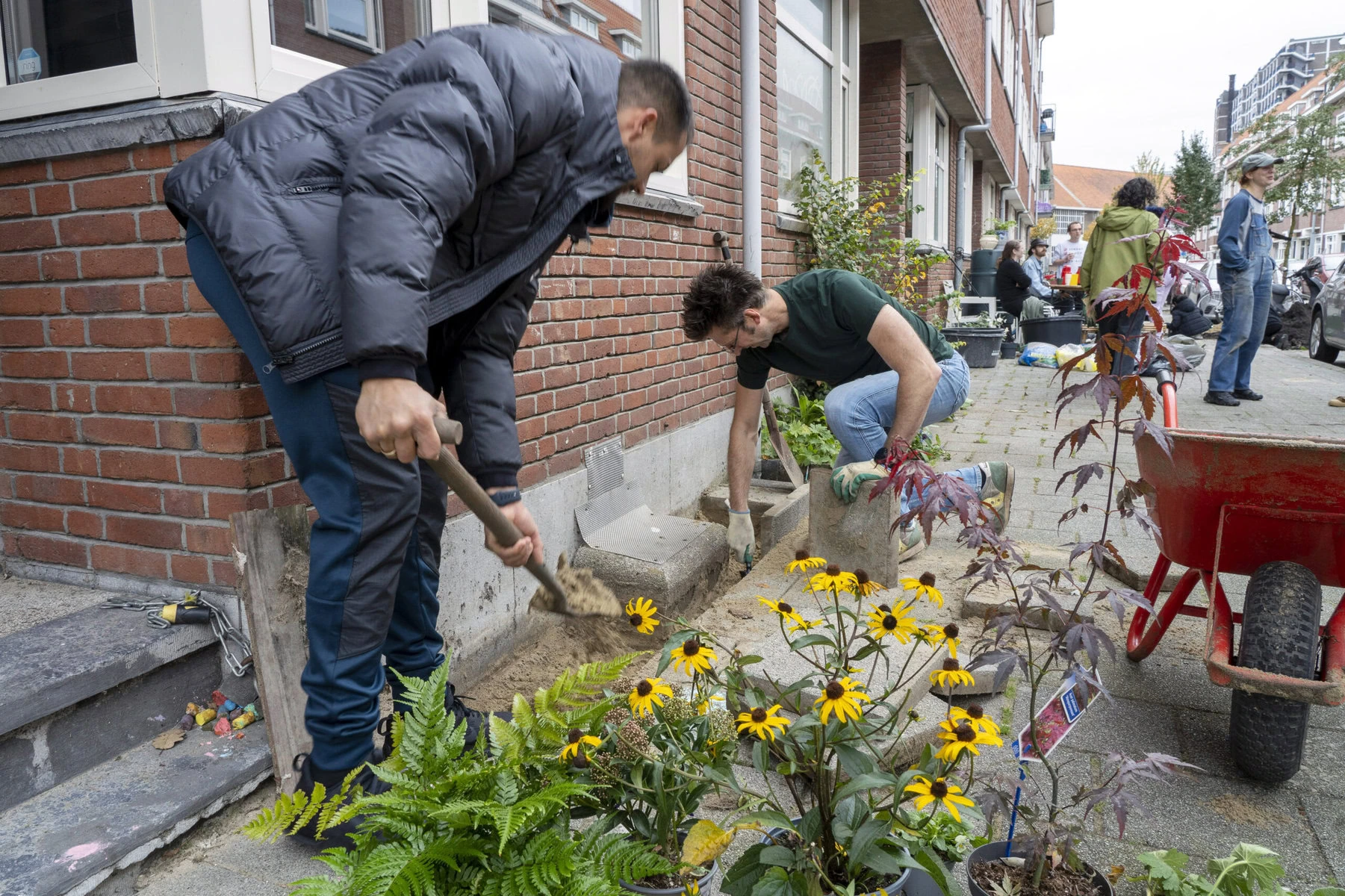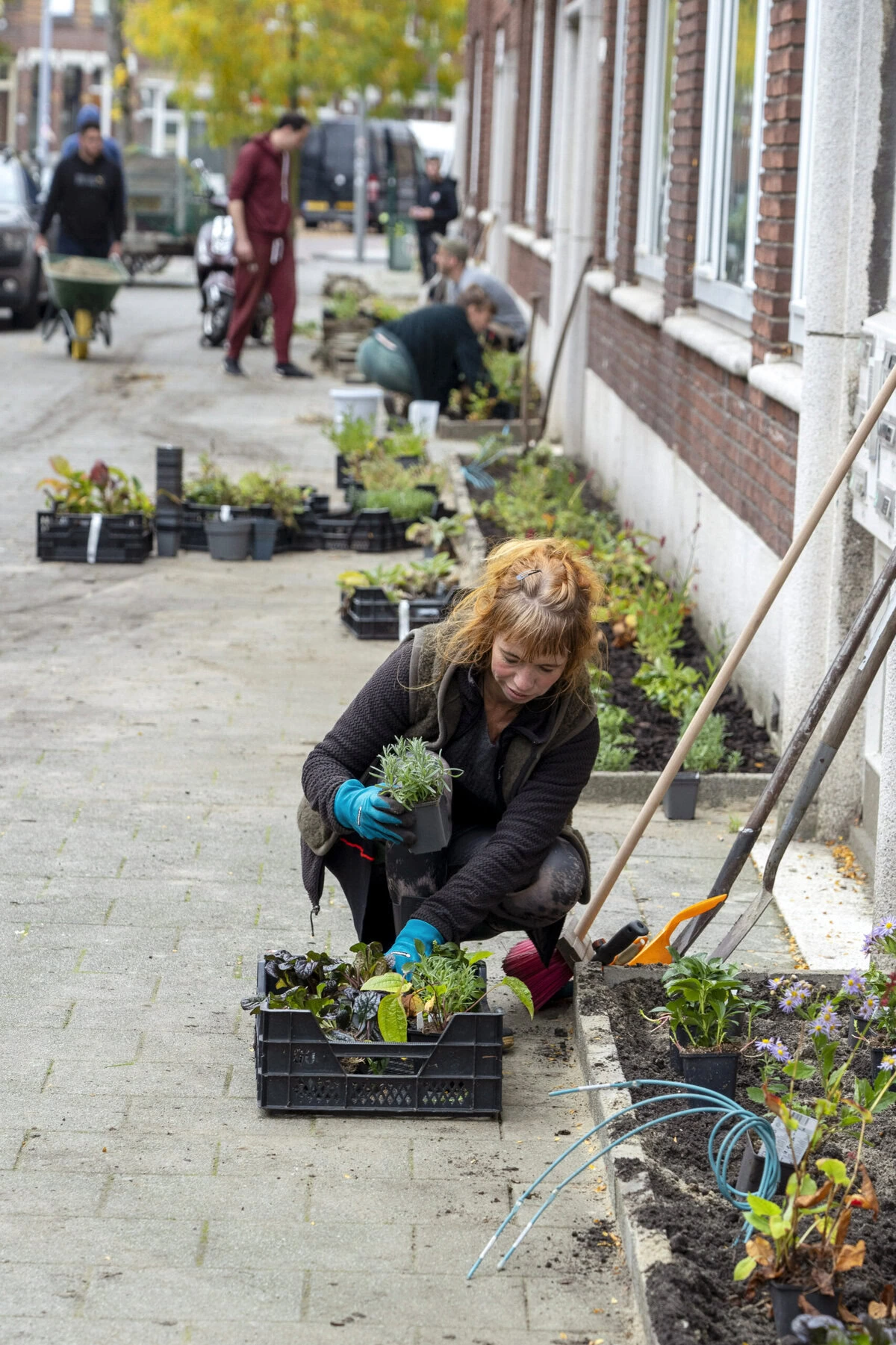Unadorned houses and gray sidewalk slabs line the street of the Katendrechtse Lagendijk neighborhood. Here in the Charlois district in the south of the Dutch port city of Rotterdam, the dreariness is interrupted only by a few puny trees. Their survival does not seem assured. In summer, the street heats up quickly, and in heavy rain it is often flooded.
“It will look very different here tonight,” says Boris Stein. It’s Saturday morning, and he has just gotten up. He is wearing wine-red jogging trousers. Holding a coffee mug and a hand-rolled cigarette in one hand, he greets Raymond Landegent with the other. Landegent has just put on his work trousers. On the sidewalk are wheelbarrows with shovels and spades, a trailer with plants and construction sacks full of topsoil.
By the evening, with the help of numerous neighbors, Stein and Landegent will have completely transformed this stretch of sidewalk. Their task: to unseal paving slabs and replace them with flower beds across a 100-meter area.
Here in the Netherlands, citizens regularly tear up sealed surfaces and plant flowers in an effort to combat overheating and flooding. The government not only accepts this practice, which is known as tegelwippen — it actually provides support.
Tegelwippen is about more than just planting pretty flowers. As the climate crisis increases heat, drought and heavy rainfall, urban, concrete-covered areas can’t easily adapt to the changes. Buildings and sealed surfaces heat up and contribute to further warming of the climate. Yet more and more ground is sealed over, preventing rainwater from seeping into the ground. New houses are built, along with parking lots, roads, shopping centers, airports and commercial buildings. According to the European Environment Agency, between 2000 and 2018, around 6,178 square miles were sealed in the European Union, more than twice the area of the London metropolitan region.
Though the annual increase has fallen slightly in recent years, around 270 square miles are still added every year — the equivalent of over 90,000 soccer pitches. In Asia, the growth rate is even higher. And in North America, the area covered by impervious surfaces nearly doubled between 1985 and 2020.
Weighed down by negative news?
Our smart, bright, weekly newsletter is the uplift you’ve been looking for.
The more cities are paved over, the greater their need for cooling and areas where rainwater can seep away and be stored. This is why in the Netherlands, citizens are taking matters into their own hands.
Tegel means tile in English. Wippen means rocking or picking up. In the last five years, Tegelwippen has developed into a mass movement across the country. The aim is to unseal as many surfaces as possible, whether in private gardens, schoolyards, driveways, public squares or sidewalks, as in the Katendrechtse Lagendijk.
Landegent reaches for the chisel to lever up the first paving slab. “Give me the spade, please, so I have better leverage,” he says to Stein. Then the slab comes loose. With a groan, Landegent lifts it and sets it aside.“The first paving slab is always a special moment,” he says with a smile.

Gradually, more and more people arrive. Neighbors with children come out of their houses to lend a hand, as do two young men who have just moved onto the block. They happily reach into the bag of honey waffles on offer. No one is bothered by the black soil on their fingers from gardening.
As neighbors pass by to do their shopping, they offer friendly greetings or snap photos with their smartphones. A friend arrives on a cargo bike with a sound system mounted on it, and loud reggae bass creates a party atmosphere. The group of helpers becomes more and more colorful. Charlois is an immigrant neighborhood, as evidenced by Polish grocery stores, kebab snack bars and stores selling Turkish bridal fashion. “We went from door to door to encourage people to join in, and almost everyone responded very positively,” says Bjefke Bonnema, wiping her forehead with the back of her hand. The project’s social manager is wearing a vintage green training jacket and leopard-print rubber boots. “It’s good to get your hands dirty and make a difference,” she says.
The piles of paving slabs on the side of the road keep growing. The city council collects them free of charge with the so-called Tegeltaxi. Private garden owners as well as institutions or neighborhood groups can call the taxi. “All it takes is a phone call or an email,” says Landegent.
He is the city’s representative for Tegelwippen, helping volunteers to carry out a campaign and procure gardening tools, topsoil and plants at the city’s expense.

Citizens can ask him for help with Tegelwippen. But they don’t have to.
In the Netherlands, every citizen is allowed to clear and plant a strip of paving slabs up to 50 centimeters away from the house wall without asking the authorities. “We want as many people as possible to take responsibility for making cities greener and therefore more resilient to the climate crisis,” explains Landegent as he rolls up a blue fiber optic cable that was buried in the sand bed under the tiles. Later, he says, they’ll lay the cable back in the bed. Doesn’t the network operator have to agree to this? Or send a fitter to supervise? Or doesn’t the homeowner at least have to be informed? Landegent smiles and shakes his head. Dutch people — who are accustomed to taking matters into their own hands — would never ask such questions, he seems to think.
Landegent’s employer, the city of Rotterdam, is among the almost 200 other cities and municipalities in the country that have taken up the idea of the Tegelwippen.
The practice first came about thanks to the creative agency Frank Lee from Amsterdam. “We developed the Tegelwippen during a brainstorming session,” explains co-founder Eva Braaksma. “When Covid-19 broke out, the whole thing took shape. People were at home more often — and therefore in the garden a lot.” There were also no soccer matches during this time. Why shouldn’t the rival cities simply compete with each other for the number of tiles lifted? Frank Lee organizes the ongoing competition, now with the support of the Ministry of Infrastructure and Water Management. Locally, there is often help from cities and municipalities as well.
According to Frank Lee, nearly 13 million tegel have been removed since 2020, which corresponds to around 1,175,825 square meters, or about 235 soccer pitches. Last year alone, around 5,552,043 tiles were removed, equal to the area of 100 soccer pitches. The removal of asphalt or concrete surfaces also counts; the square meters uncovered are converted into tegel.
In Rotterdam, 250,000 tegel were taken away last year. This would not have been possible without people like Cato de Beer and her neighbors. With her reddish-blonde hair tucked under her washed-out cap, the young woman stands in Moerkerkestrat and looks on contentedly at the goings-on of her neighbors, hands in the pockets of her jeans. Dock workers used to live in the simple terraced houses from the 1920s. Today, just like in Katendrechtse Lagendijk, a five-minute walk away, this neighborhood is home to a colorful mix of residents. There is a street party atmosphere here, too. “We’re doing this for the second time this year, the first time was in the summer,” says cultural manager de Beer. A lot has happened in the neighborhood as a result of the Tegelwippen. “I’ve got to know a lot of neighbors through it,” adds de Beer, who only moved onto the street a year and a half ago.
Miriam Watson nods in agreement. Sporting dreadlocks and a lime-green sweater, she is currently watering one of the new flower beds. She has lived in the area for some time. “It’s considered a problem neighborhood here,” she says, “but look how well everyone works together.”
It’s no wonder that Tegelwippen is being replicated in neighboring countries.
It recently spilled over the border into Germany.“We want to take up Tegelwippen,” says Susanne Dickel on a tour of various squares in Düsseldorf on the Rhine. Her initiative “Platzgrün!” has unsealed, greened and redesigned these squares in cooperation with the city. There are now lawns, flower beds, park benches and even some boules courts on former parking lots, abandoned areas, dog waste grounds and traffic islands. The city has financed equipment, soil and plants, and the Platzgrün! initiative organizes volunteers for the landscaping of the squares.
Tegelwippen is now due to start on six areas in Dusseldorf in the spring. Hamburg in the north of Germany will also pick up the idea. “Hopefully it will also trigger an anarchic, grassroots democratic mass movement in Germany, as it did in the Netherlands,” Dickel says.
The post In the Netherlands, Anyone Can Turn a Slice of Sidewalk Into a Garden appeared first on Reasons to be Cheerful.




